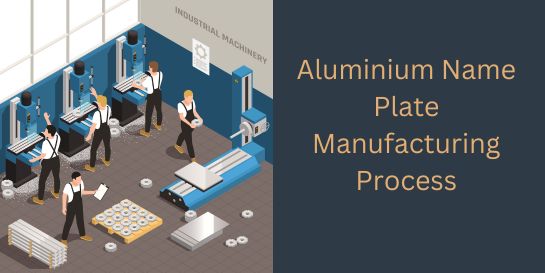Aluminium name plates servers as essential tools for the identification and branding of several industries. A detailed description of the manufacture of these nametags exposes the high degree of artistry and skills needed to make solid and beautiful finished products. From design concept to quality control, every single step is essential to the function and appearance of aluminium name plates. Let's look at the remarkable story of aluminium name plate production.

The design stage should be addressed before production. The next phase is coming up with a layout of how the aluminium name plate will be designed or branded including how large it will be and its shape. Designers work hand-in-hand with the clients to establish the requirements and then draw mock-ups or digital representations for approval before moving on.
The selection of the right aluminium material is critical to the quality and durability of the name plate. The factors like the intended use, surrounding conditions and allocated budget play a role in material selection. Varieties of aluminium are found in different grades and thicknesses each with different characteristic in relation to strength, corrosion resistance, and finish. Manufacturers take into consideration these factors to make sure the material selected stands in line with the set objective of the name plate and functional requirement.
The first stage of fabrication of aluminium name plates is cutting and shaping of aluminium sheets to desired dimensions and design specifications. Advanced cutting tools like laser cutters and CNC machines are employed to enhance accuracy and uniformity in the finished product. Skilled technicians operate the machinery with care to get accurate cuts and shapes resulting in minimal material wastage and high efficiency.
Having cut the aluminium sheets to their required size, the next step is to add the required design elements, text, and or graphics onto the surface. It can be done with printing or engraving. To print the design, screen printing or digital printing can be used which will transfer the design clearly and precisely onto the aluminum surface. By contrast, engraving approaches, which include laser engraving or mechanical engraving are utilized to etch the design onto the aluminium thus generating a lasting and durable marking.
The aluminium name plates are polished and other process are carried out for a good appearance, long life and resistance to corrosion from the environment. It may include, for example, anodization which creates a protective oxide layer on the surface and consequently prevents corrosion and improves the scratch resistance. The other finishing options include applying protective sealants of aluminium or applying decorative finishes paints or powder coating for color and texture. These surface treatments not only make the nameplates attractive but they also ensure proper functioning of the nameplates in various applications.
The name plates of aluminium are throughly checked for quality control procedures and for any imperfections and defects before finalizing the design. Skilled inspectors scrutinize support plates paying considerable attention to any inconsistencies in designs, engraving or engraving errors, surface defects and other problems that could spoil the end product. All imperfections detected are documented and reported immediately in order to keep our standards high.
Besides visual inspection, durability testing is carried out to determine the resistance of aluminium name plates to several environmental factors and different mechanical stresses. The testing may include exposure to extreme temperatures, humidity, UV radiation, abrasion, and chemical resistance evaluation. Product manufacturers undergo stringent durability tests to prove beyond doubt that the labels withstand brutal conditions, keeping their features and functionality in check all the time and consequently meeting the requirements of customers.
The production of aluminium name plates demands systematic attention to detail and rigorous quality controls at every step. Starting from the design conceptualization to the final inspection, every step is vital in assuring the production of top-notch name plates that fit different application purposes. By sticking to strict standards and using advanced fabrication methods, manufacturers can produce aluminium name plates that are durable, pleasing to the eye, highly reliable, and fulfill well their intended purposes than other types of writing plates in various industries.